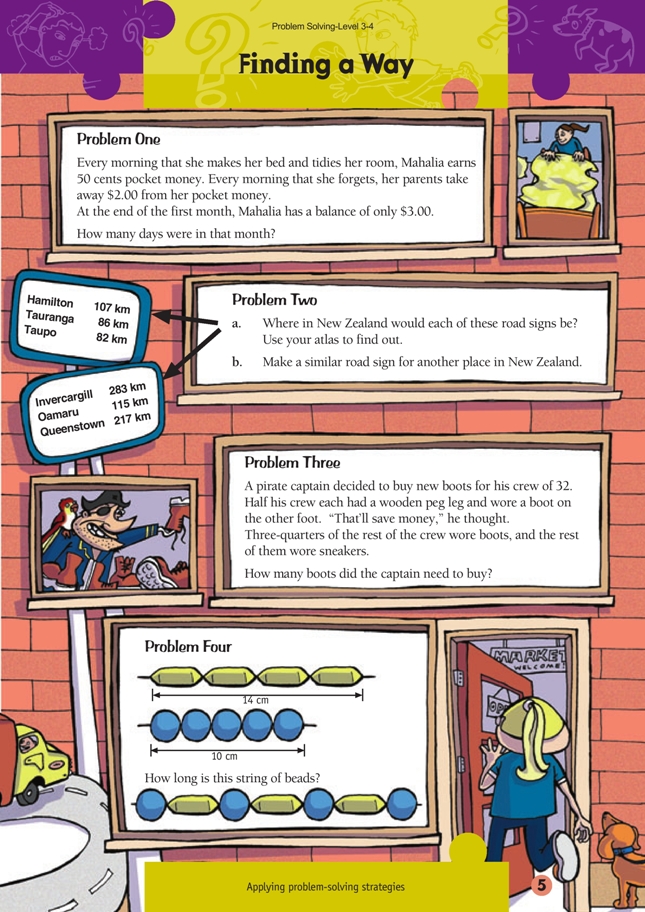These are level 4 number, and geometry problems from the Figure It Out series.
A PDF of the student activity is included.
Click on the image to enlarge it. Click again to close. Download PDF (393 KB)
use addition, multiplication and systematic approach to solve problems (Problem 1)
interpret distance and direction information on a road map (Problem 2)
find fractions of whole number to solve problems (Problem 3)
use simple ratios to solve problems (Problem 4)
Problem One
The students need to look carefully at the information provided and see what they can deduce from that information.
Overall, Aroha made 30 cents, so she must have made her bed for at least 6 days (6 x 5c = 30c). For the rest of the month, the amount she earned making her bed must have been cancelled out by the non-making days. Four days of making are cancelled out by 1 day of non-making, which is a set of 5 days. So the number of days in the month must be 6 plus a multiple of 5, that is, 6, 11, 16, 21, 26, 31, 36, and so on. Months can be 28, 29, 30, or 31 days. The only number of days that fits is 31 days, so there must have been 31 days in the month.
Extension
You can extend this problem by changing the amounts of pocket money in the question. The students could suggest some amounts.
You can also turn the question around. “If there are 30 days in the month, what amounts of money can Aroha earn?” (You can introduce negative numbers this way.) “Is there a pattern in these amounts?” “If Aroha earned 80 cents in a month, what could you say about the month?”
“Suppose it was a 31 day month and Aroha got 5 cents for making her bed. If she earned 65 cents that month, how much did she lose for a non-bed-making day?”
Another scenario is to have neutral days. “On the days when the family went over to see Granny, they had to leave early in the morning, and so they didn’t have time to make the beds. In a 30 day month when Aroha earned 70 cents, how many Granny days were there?”
Problem Two
To solve the problem, the students could use the map’s scale to find what distance is equivalent to 107 kilometres. They then set a compass to this distance and draw a circle on the map with Hamilton at the centre. (They will need a photocopy of the relevant pages of an atlas to draw on.) They repeat this with an 86 kilometre radius circle from Tauranga and an 82 kilometre radius circle from Taupo. The three circles will have an area in common. The biggest town in the common area will be where the road sign is.
They can use the same approach for the second road sign.
Problem Three
Half the crew (16) had only one leg and wore a boot on that leg. So the captain needed to buy 16 boots for these crew members.
Three-quarters of the rest of the crew wore two boots: 3/4 x 16 = 12. These 12 crew members needed two boots, a total of 24 boots.
Altogether therefore, the pirate captain needed to buy 16 + 24 = 40 boots.
Extension
Boots are usually sold in pairs. Students could consider what difference it would make if the captain could only buy pairs of boots. They could consider a scenario where the pirates had an equal number of left and right feet or one where there were more right feet needing boots than left feet. Would shoe size be an issue?
You could reverse the problem and tell the students that the captain bought 35 boots.
“What fraction of his crew had only one leg?” (All the other data could stay the same.)
This problem can also be used to give the students practice with fractions other than 3/4.
Problem Four
A long bead is 14 ÷ 4 centimetres. A round bead is 10 ÷ 5 centimetres. So the new string of beads is (3 x 14 ÷ 4) + (4 x 10 ÷ 5) = 10.5 + 8 = 18.5 centimetres.
Extension
The students could make up their own questions for other students to solve.
Hints for Students
1. How many days of bed making does it take for Aroha to make 30 cents?
How many days of making and not making her bed does it take for her to break even?
2. You could guess and check, but there are a lot of places on the map to check.
How could you cut the guessing down?
3. How many of his crew have a peg leg? How many boots will they need?
Now work out the boots for the rest of the crew.
4. How long is one bead of each shape?
Answers to Problems
1. 31 days
2. The first sign is in Rotorua and the second is in Dunedin.
3. 40 single boots (16 single boots for those with wooden legs and 12 pairs of boots for 3/4 of the rest)
4. 18.5 cm
